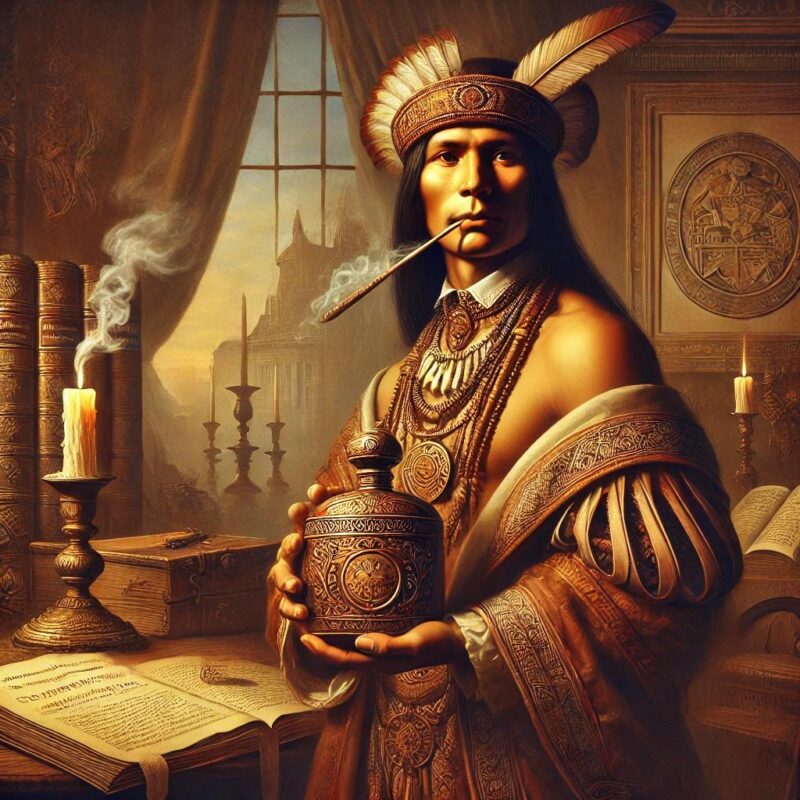FOREVER THE FOREST, Rapé Snuff
The History of Snuff in Europe: Influential Figures and the Church’s Role
Smoke, Spirit, and Sacred Traditions: The Forgotten Story of Snuff in the Old World
There is a certain poetry in the way the Earth shares its medicines. Like rivers carving their paths through time, sacred plants find their way into human hands, whispering secrets to those willing to listen.
Among these, tobacco has long been a revered plant—a bridge between worlds, a messenger between the seen and unseen. Before it was commodified and reduced to addiction, tobacco was a sacrament, a portal, a guide. And in the form of snuff, it carried prayers across continents, from the deep jungles of the Amazon to the grand halls of European nobility.
But how did a sacred medicine of Indigenous tribes become a symbol of power in European courts? And what role did the Church—so often caught between reverence and repression—play in this journey?
This is a story woven with paradoxes, with saints and sinners, with emperors and Indigenous shamans, with inquisitors and alchemists. A story of how an ancient medicine was embraced, transformed, and nearly forgotten—only to be reborn in our time.
Tobacco’s Arrival in the Old World
When the first European explorers reached the shores of the Americas, they found that tobacco was already deeply embedded in the spiritual and medicinal traditions of Indigenous cultures. The peoples of the rainforest did not “smoke” in the modern sense; they communed. They offered tobacco to the spirits, to the Earth, to the Great Mystery that holds all things.
Among them, the art of snuffing—taking finely ground tobacco through the nose—was a powerful practice, used to sharpen the senses, clear the mind, and open portals of perception. The tribes of the Amazon, such as the Yawanawá, the Huni Kuin, and the Katukina, still use Rapé today as a sacred tool for prayer, focus, and spiritual alignment.
Europeans, unfamiliar with such uses, initially saw tobacco as an exotic curiosity. But as explorers returned with tales of its potency, the plant quickly took root in the courts of the Old World.
The Rise of Snuff in European High Society
By the 16th and 17th centuries, snuff had become the preferred way to consume tobacco among the European elite. Unlike smoking—viewed as crude and peasant-like—snuff was refined, elegant, a sign of intelligence and distinction.
Catherine de’ Medici, the Queen of France, is often credited with popularizing snuff among the nobility. Suffering from chronic migraines, she was introduced to the powdered form of tobacco by Jean Nicot, a French diplomat who had encountered the plant in Portugal. Upon finding relief, she declared snuff a cure-all, calling it Herbes à la Reine—the Queen’s herb.
Soon, snuff was everywhere: in golden boxes carried by European monarchs, in the chambers of philosophers and artists, in the pockets of revolutionaries and visionaries. Napoleon Bonaparte was known to consume massive amounts daily, believing it aided his mental clarity. Even Pope Benedict XIII was an avid user, going so far as to lift previous bans on its use by clergy.
But while kings and queens indulged in the powdered medicine of the Americas, the Church itself remained torn—oscillating between reverence and condemnation.
The Church’s Complex Relationship with Snuff
From the moment tobacco arrived in Europe, the Catholic Church struggled to define its stance. Was it a gift from God or a temptation of the devil? A medicine or a vice?
Early on, the clergy took issue with the ecstatic states and altered consciousness that tobacco could induce. The idea that Indigenous shamans used snuff to commune with spirits did not sit well with an institution that sought to control the gateways of mystical experience.
In 1642, Pope Urban VIII issued a papal bull banning the use of snuff in churches, condemning it as a distraction from prayer. Some bishops even claimed that sneezing—an effect of inhaling snuff—was akin to a sinful bodily pleasure. And yet, despite these prohibitions, tobacco use among the clergy remained widespread.
By the 18th century, attitudes had softened. The Church, seeing that tobacco was not disappearing but rather becoming a cornerstone of European culture, adjusted its position. By the time of Pope Benedict XIII, who personally enjoyed snuff, bans were lifted, and the practice was embraced even within Vatican walls.
Thus, what was once a sacred tool of Indigenous ceremony became a staple of European aristocracy—stripped of its spiritual context, but still carrying whispers of its ancient power.
The Fall and Rebirth of Snuff
As time went on, industrialization and commercialization changed tobacco forever. What had once been medicine became addiction. What had once been sacred became profane. The deep, intentional use of tobacco among Indigenous peoples was overshadowed by mass production, cigarette factories, and the numbing spread of nicotine dependence.
By the 20th century, snuff had nearly disappeared from popular culture. The fast-paced world of cigarettes had no patience for the slow ritual of finely powdered tobacco.
But in the 21st century, something remarkable began to happen: a return to the roots. A remembering. A call from the forest that began to awaken those who had forgotten.
A Return to the Sacred
Today, as the world hungers for authentic spiritual experiences, ancient medicines like Rapé are making their way back—not as trends, but as guides. The Indigenous keepers of these traditions never stopped practicing, never stopped honoring the spirit of the plant. And now, they are sharing their wisdom with those who seek.
In places far from the Amazon, seekers are rediscovering the power of snuff—not as a habit, but as a ceremony. Not as a pleasure, but as a prayer.
At Queen of the Forest, we honor this sacred lineage. We believe that the medicines of the rainforest are not relics of the past, but vital tools for the present—a bridge between worlds, between ancient and modern, between forgotten and remembered.
Listening to the Call
The journey of snuff—from the shamans of the rainforest to the courts of Europe, from sacred rituals to forgotten habits, and now back to its roots—is a reflection of a greater cycle. It is the story of how wisdom moves, how it hides, how it waits, and how, when the time is right, it returns.
Perhaps you, too, feel the call. A longing for something deeper, something older than modern life can offer. If so, know that the doors are still open. The forest still speaks.
And if you wish to listen, the medicine is here. Waiting.
Explore the sacred Rapé of the Amazon. Remember. Reconnect.


